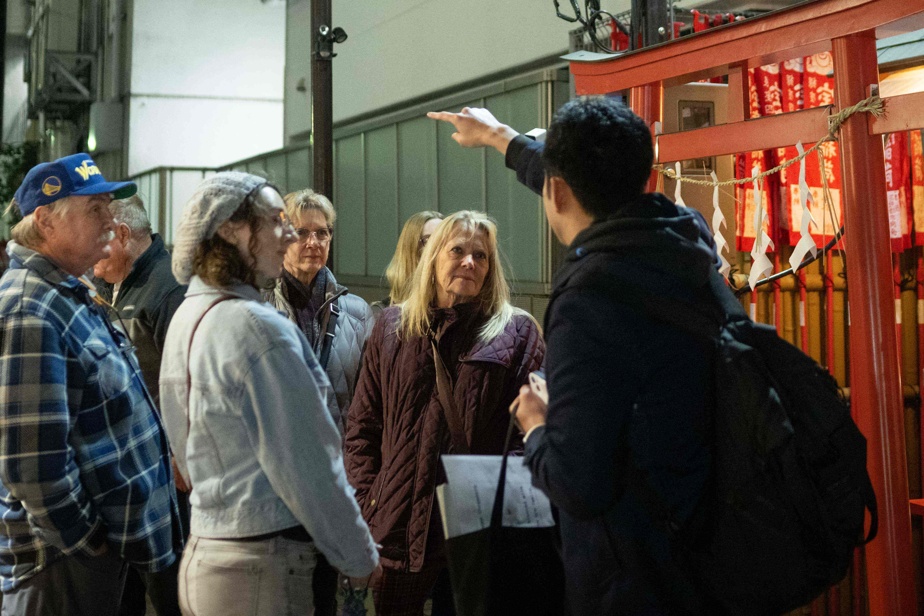(Tokyo) In a Tokyo street lined with neon signs, at the top of a narrow staircase, an uninviting door opens onto a “ snack bar », a place popular with regulars, but almost invisible to tourists until now.
These cozy, retro bars, often nestled on the upper floors of buildings, are generally run by a woman nicknamed “mama”, who chats with customers while serving them drinks, peanuts, dried squid and other small snacks.
Even though ” snacks » are an integral part of Japanese nightlife, their discreet and hidden nature can be intimidating, especially those who do not speak the country’s language.
It is for them that an agency has decided to offer guided tours of snack bars such as Kuriyakko, in the Tokyo district of Shimbashi.
Inside, dim lights reflect warmly off the red tiles, illuminating an art-deco poster while an American family sings the hits Hey Jude And Take Me Home, Country Roads.
Nora, who previously lived in Japan, explains to AFP that she booked the visit for her parents, sister, aunt and uncle after learning about it on Instagram.
One hundred thousand snacks in Japan
“I have always seen the signs of snacksbut I didn’t really know how to get in or what to do there,” explains this thirty-year-old, now based in San Francisco and who only wanted to give her first name.
“My family doesn’t go to Japan often, so it was a good opportunity to really experience bar culture” in a “jovial” and “intimate” way.
The guide from the Snack Yokocho agency explains to the group how to order whiskey and plum wine “umeshu” in Japanese, and how to say “health” (“kanpai!”).

PHOTO YUICHI YAMAZAKI, AGENCE FRANCE-PRESSE
The tours take place in the Tokyo district of Shimbashi.
Dressed in an elegant pale pink kimono and wearing a traditional bun, “mama” Kuri Awaji, who has worked behind the Kuriyakko bar for 25 years, accompanies customers as they sing along to karaoke.
According to Snack Yokocho, Japan has around 100,000 snack bars. Although women officiate most of the time, some are run by men.
Although the atmosphere is less social than in modern host and hostess bars, with the emphasis on friendly conversation, the snack bars are still historically linked to the “red light districts” of Japan.
After World War II, some women turned to sex work to survive, but anti-prostitution laws were introduced around the time of the 1964 Olympics, says Snack Yokocho representative Mayuko Igarashi.
To earn money, they “put a simple wooden box in the street and started serving drinks and snacks there. snacks », hence the name of these establishments.
More and more female customers
Many of them were divorced and raised their children alone, hence the nickname “mama”, according to Mme Igarashi: “It was difficult for them to work during the day, so once the children went to bed, they manned the counter,” she explains.
According to Mme Igarashi, there would have been 200,000 snack bars in Japan in the 1950s and 60s, but their numbers declined as “mama”s retired or sold their businesses.
Now, with record numbers of tourists visiting Japan, Snack Yokocho says interest in its tours is growing.
Besides the snacks “classics” like Kuriyakko, the company goes to snack bars theme, one of which specializes in golf.
She also sometimes organizes guided tours for Japanese women who wish to discover the culture of the snacksbut who hesitate to open their doors alone.
For years, the clientele of these bars was almost exclusively male, according to Mr. Igarashi. But with the increased presence of women in the labor market, snacks have become a “place where they can relax or talk to mom about their problems”.
People tend to talk on social media, but after a bad day, nothing beats face-to-face communication, she says.
” In a snack bar, people can look into each other’s eyes and get to know each other very quickly, even strangers. »
